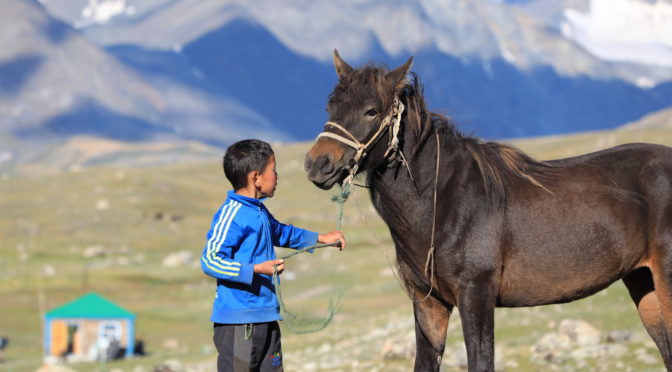WHITE RIVER TO ÖLGYI (23-Aug-2018)
I woke up in a Mongolian ger (a yurt in Turkic) next to the White River at the South Ranger Station. Between my sleeping mattress and the damp grass was a carpet, hand woven and colourful. The gaps between the circular wall and the ground had let the chilly air in all night. Without the insulation that a small tent would provide, the ger, without heating, was cold. It had been kept warm until midnight with a fire fuelled by a generous pile of dried camel dung. The owner of the ger had tiptoed in quietly, thinking I had gone to sleep, to keep the fire alive. He had been kicked by a horse during the day, and his walking posture indicated severe back pain. Before shutting the door firmly behind him, he left a wolf skin near the fire in case it could provide extra warmth later on.
Up in higher altitude, I had slept reasonably well in my own tent, at times woken up by the sound of the wind, the murmuring ripples of the stream separating the base camp from the ancient glacier, the neighs of a startled horse, the snores of mountaineers carried by the wind – uninvitedly – from surrounding tents, and, as the sun was rising, by the songs of whistling kites. But this last night, I could not sleep at all. With the energy of Malchin Peak still flowing freely through the body, I rested in a lying position, but longed to sit on horsebacks looking up at the bright moon. The moon, rising large above ridges disappearing into the horizon, with the poise of a camel before a long day’s work, looked a week away from fullness. Like a wolf, I was alert and calm, ready to howl all night singing praises of the moon and her wise silence.
Looking up through the crown in the middle, I could see the first light starting to cut through the darkness. The crown is of extra significance when it comes to assembling a ger. One can tell how big a ger is by examining the size of its crown. Due to its circular shape, it needs to remain one piece when the ger is disassembled for transport as the nomadic family moves from one place to another. A typical ger provides load for about four to five camels, with the crown – due to its bulky size – packed flat and balanced on top of something else above the camel’s two humps. Packing a ger and loading camels with the disassemblies would take some skills. Considering that a ger can be put together in about two hours, it says a lot about the efficiency in design and the resourcefulness of these nomads.
It was time to say goodbye to the Tavan Bogd National Park as we embarked on a 220km trip from the South Ranger Station to Öglyi. The trip would take about 6-7 hours on unsealed paths, down hills, through valleys, over great plains often intertwining with the White River – crossing carpets of green grass dotted with wild flowers, deftly avoiding muddy traps signified by patches of brown – which would soon merge with the Black River to form the “Grey” flowing east.
I emptied all the chocolate and snacks out of the duffle bag and gave them to the children of the ger. In the soft light of the morning, my Canon managed to capture some timely photos of the boy as he jostled a horse around, the same one which had kicked his father the day before. At times, the boy would ride the horse with vigour, darting off up a hill to urge back some more cows and yaks. I admired these children, and decided then and there that it was time to introduce Hunter to more mountain peaks. This boy looked eight or nine. Hunter was twelve.
Chuang Tzu of ancient China had said this to those who listened: “When life was full, there was no history.”
In the age when life on earth was full, no one paid any special attention to worthy men, nor did they single out the man of ability. Rulers were simply the highest branches on the tree, and the people were like deer in the woods. They were honest and righteous without realising that they were “doing their duty.” They loved each other and did not know that this was “love of neighbour.”
They deceived no one yet they did not know that they were “men to be trusted.” They were reliable and did not know that this was “good faith.” They lived freely together giving and taking, and did not know that they were generous. For this reason their deeds have not been narrated. They made no history.
I felt the same way about this Mongolian family, and many other locals, during the past week travelling through this magical land. There will not be many tales told of these people. There is no need. Silent gestures of caretaking, spontaneity in doing just what is needed to survive, free flowing milk, and belly laughter at all kinds of ideas are a way of life over here.
Similarly to how many misinterpreted and rejected Chuang Tzu, many visitors will also reject the nomads’ way of life as primitive, obsolete and uncivilised. A couple of trekkers had arrived a few days before, and, after taking one look at the ice capped Mount Khüiten, were in an immediate hurry to cancel everything to return to their “civilisation”. During a very short time, I had come to feel at home amongst these quiet folks. Mountain peaks, azure lakes and white rivers, whistling kites weaving paintings in the deep sky, snowflakes in summer, double humped camels with such perfect poise, nomads scurrying about all day with horses and jeeps – they were as natural to me as my little shed and dear troops back in Melbourne.
On the way, we passed by a Bronze Age burial ground. A blue stone signifying the red deer has a symbol of war at the top. Next to it is a long white stone representing a human, clearly someone of importance, appearing to be embracing the blue stone. The Red Deer, together with the Blue Wolf, are believed to be ancestors of the Mongols.
In the background, we could spot a Muslim spiritual site, with its prominent mosque and long white walls. We asked the local nomads for information on eagle hunting families. They had all left the region, so I did not get to have a direct experience of hunting with those majestic birds. Eagle hunting was quickly becoming out of fashion, going the same way as positioning and directional traditions within a ger, only to be replaced by a booming mining industry and tourist dollars. The day I see a McDonald’s or a Starbuck’s in this part of the world will also be the day I will not feel a need to return here. Most locals feel the same way, but they feel their voices are not loud enough to reach the authorities.
Then we arrived at a little Kazakh town. The women in the kitchen gave us each a warm bowl of Kazakh tea. The little children giggled at the sight of strangers who clearly looked out of town. After about a week off grid, I managed to get some signal to call home and deal with urgent matters. The local scenery up the hills from here was unusual. It was very green with tall trees. The river was full. One could have mistaken it for a region in Canada.
The next town was the same one we had passed on the way to the North Ranger Station. From here, the path looked familiar. Before too long, we were on one of the many dirt tracks that led to Ölgyi, and eventually to Ulaanbaatar. In Mongolia, all roads lead to Ulaanbaatar. In the era of Ögedei Khan’s Mongolian empire, all roads led to Karakorum. Under Kublai Khan, they led to Beijing. This development of history has as much to say about the human psyche and its vanity as its glory and greatness.
Returning to the Eagle’s Nest, where a warm bed awaited, I enjoyed a thorough clean up, at the same time missing the last lingerings from the Altai that had left its unmistakeable mark on my body, my clothes and luggage. Its mark on my soul, however, would be with me for as long as my memory holds.
The special treat of the evening was a heartwarming dinner, over sweets and horse meat and songs and milk tea, hosted by a local Kazakh family in their ger. The Kazakh ger is a bit larger and more colourfully decorated than a Mongol ger. The lady of the house had spent four hours cooking horse meat. We washed our hands and said a prayer. I shared with the hosts how a Japanese would say “Itadakimasu” before a meal. Many youngsters today have forgotten about the meaning of these rituals. If they had remembered, they would not have bothered themselves with questions about the meaning of life. The man of the house cut the meat and potatoes and shared the meal with us. He left, returning after a short while with his son, each dressed in a traditional Kazakh gown and holding a dombyra. It was time to sing songs about friendship, about freedom on the hills, and about what golden eagles see as they soar high above the Altai. There was even a legato rendering of Sailing, originally by the Sutherland Bros, later made famous by Rod Stewart.

